In the article, you will learn about SIGNED and UNSIGNED integer data types in MySQL. The article provides information about integer types with the ZEROFILL, AUTO_INCREMENT, and display_width attributes, as well as describes examples of when and how to use integer data types.
Contents
- What is MySQL INTEGER
- SIGNED vs UNSIGNED
- What is UNSIGNED INT Data Type
- INTEGER Display Width: INT()
- MySQL INT with the ZEROFILL attribute
- MySQL INT Types
- TINYINT Example
- SMALLINT Example
- MEDIUMINT Example
- BIGINT Example
What is MySQL INTEGER
In MySQL, INTEGER (INT) is a numeric value without a decimal. It defines whole numbers that can be stored in a field or column. In addition, MySQL supports the display_width attribute (for example, INT(1)) and the ZEROFILL attribute, which automatically adds zeros to the value depending on the display width.
Except for standard INT and SMALLINT data types, MySQL supports TINYINT, MEDIUMINT, and BIGINT numeric data types that can be SIGNED and UNSIGNED.
The table displays the allowable storage in bytes and the maximum and minimum values of SIGNED and UNSIGNED integer data types.
| Type | Storage (bytes) | Minimum Value SIGNED | Minimum Value Unsigned | Maximum Value Signed | Maximum Value Unsigned |
| TINYINT | 1 | -128 | 0 | 127 | 255 |
| SMALLINT | 2 | -32768 | 0 | 32767 | 65535 |
| MEDIUMINT | 3 | -8388608 | 0 | 8388607 | 16777215 |
| INT | 4 | -2147483648 | 0 | 2147483647 | 4294967295 |
| BIGINT | 8 | -263 | 0 | 263-1 | 264-1 |
Usually, INTEGER data types represent IDs, width and height attributes, or serve as components of date and time values. For example, MySQL DATETIME, DATE, YEAR, and TIMESTAMP types may internally work with integer values for storage or formatting in certain operations.
SIGNED vs UNSIGNED
As mentioned before, INTEGER data types can be UNSIGNED and SIGNED. UNSIGNED can store only zero and positive numbers in a column. If the values in the column never use negative numbers or when there is a need to use a larger upper numeric range for the column, you can set UNSIGNED, which in turn may lead to a faster index.
SIGNED can allow zero, positive, and negative numbers. With the MySQL value as SIGNED, one bit is taken for the sign symbol as opposed to the unsigned ones, when they do not have signs preceding the value.
In MySQL, INT is usually selected as a primary key and can have the AUTO_INCREMENT attribute in the column.
Learn how to define and modify a MySQL primary key in this article.
For example, when you add NULL or 0 to the INT AUTO_INCREMENT attribute, the column value is automatically incremented and changed to the next sequential value generated in ascending order. When you add a non-zero value to the INT AUTO_INCREMENT attribute, the value is accepted and the sequence is reset meaning that the inserted value precedes the automatically generated sequential values (i.e. value+1). Keep in mind that columns with AUTO_INCREMENT do not store negative values, which means that columns with AUTO_INCREMENT are unsigned by default.
What is the UNSIGNED INT Data Type?
When we set the MySQL INT UNSIGNED column, it means that negative values cannot be inserted in this column. The maximum range value with the UNSIGNED data type is 4294967295, while the minimum one is 0. Thus, if you insert a negative value or one that exceeds the maximum value, you will get an error since it will be an out-of-the-range value. Let’s see the example of how to create a table with the INT UNSIGNED columns. Since ID is usually a numeric data type, we’ll use it as an INT UNSIGNED primary key.
Create a table with UNSIGNED data example
For a demo example, we will use dbForge Studio for MySQL. The Studio is a multi-featured integrated development environment (IDE) for MySQL and MariaDB databases that covers all the database-related tasks, from SQL coding to source controlling with one solution.
Let us start with creating a new products table with the total_amount column containing the INT UNSIGNED data type. For this, we utilize the SQL code editor of the Studio – a powerful coding assistant with lots of features, such as context-aware suggestions, syntax validation, code formatting, snippets library, and many more helpful options.
To begin with, connect to the necessary database (we use the test database where we can create tables and edit them).
On the standard toolbar, click New SQL to open the working area. Use the following query to create a new table and to insert a row into that table:
CREATE TABLE products(
product_id INT AUTO_INCREMENT,
product_item varchar(255) NOT NULL,
category varchar(255) NOT NULL,
total_amount int UNSIGNED,
PRIMARY KEY (product_id)
);
INSERT INTO products (product_id, product_item, category, total_amount)
VALUES (1, 'tomatoes', 'vegetables', 10);Execute the query by clicking Execute or pressing F5.
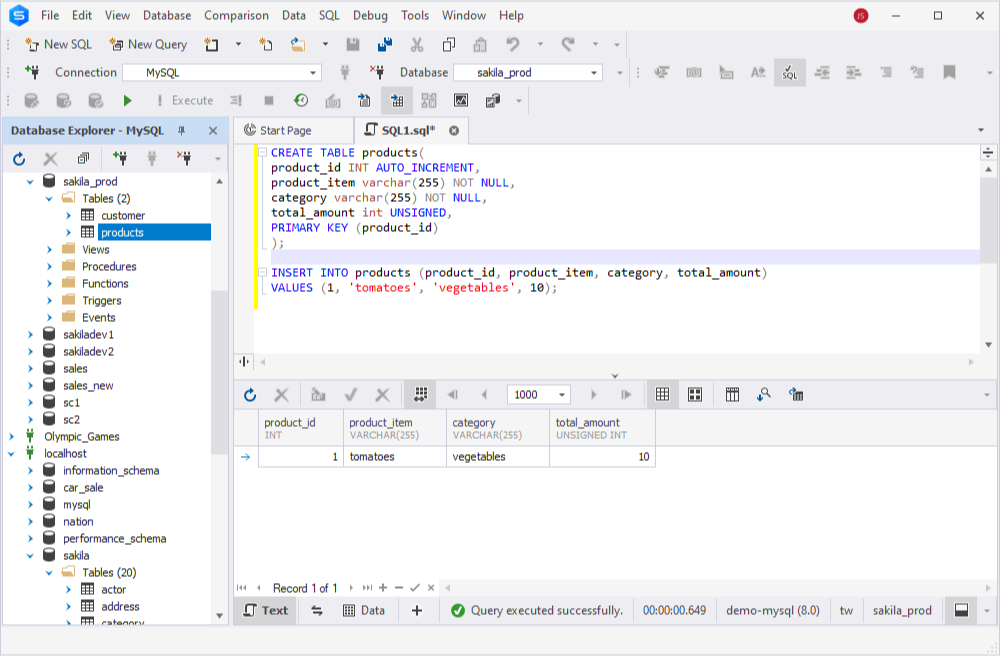
As you can see, the values were added.
Now, insert a new row but with a negative number for the INT UNSIGNED column and execute the query:
INSERT INTO products (product_id, product_item, category, total_amount)
VALUES (2, 'apples', 'fruits', -5);As you can see, upon executing the query, we got an error because UNSIGNED does not support negative values:
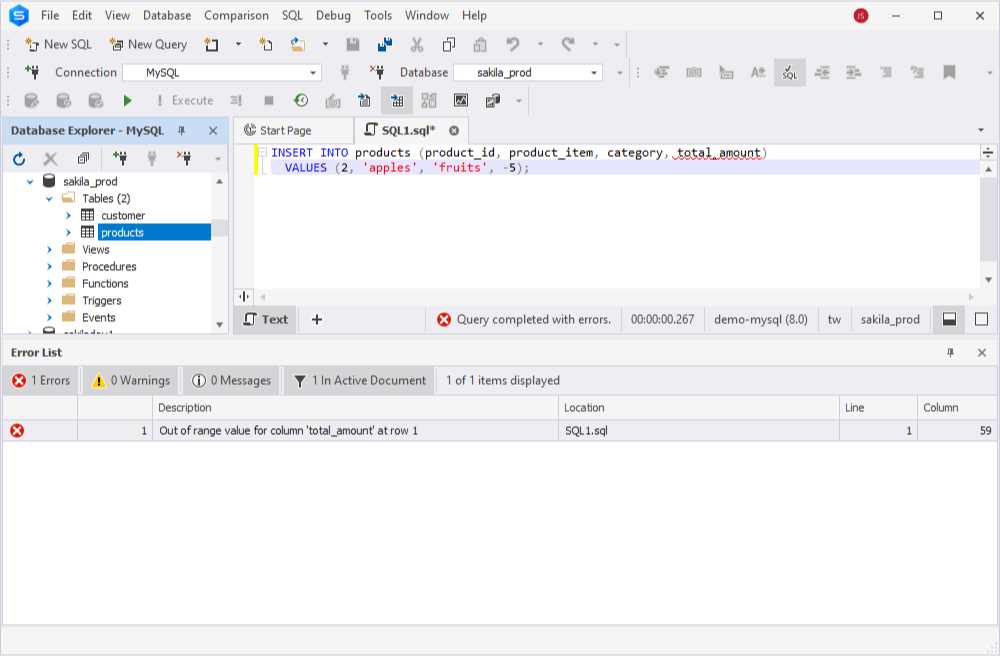
INTEGER Display Width: INT()
In MySQL, you can set the display width for the INT data type. The display width is the number in parentheses that represents the output length, i.e. how many characters should be displayed in the column when retrieving data for the column. Thus, it matters only when displaying the output.
Consider the following: If you specify 5 as a value for the int(1), int(6), int(10), and int(11) columns, they all will output the same value – 5. Actually, display width makes a difference when you set the ZEROFILL attribute. In this case, the result will display 5, 000005, 0000000005, and 00000000005 respectively.
Note that the display width does not influence the maximum and minimum value ranges. The minimum and maximum values of the column and the storage size (in bytes) depend only on the integer type you use but not on the length. The values int(1), int(6), int(10), and int(11) will have the maximum value in a range that equals 2147483647 (for signed INT) and 4294967295 (for unsigned INT).
MySQL INT with the ZEROFILL attribute
If you need to replace spaces with zeros, you can use the ZEROFILL attribute for the MySQL INT UNSIGNED column. For example, for the INT(3) ZEROFILL column with the value 1, the result you retrieve will be 001.
Note: Keep in mind that UNSIGNED is automatically added to the numeric column.
Have a look at the example. We create a MySQL ProductsNew table having columns with the ZEROFILL attribute.
In a new SQL document, execute the following CREATE statement:
CREATE TABLE ProductsNew(
product_id INT AUTO_INCREMENT,
product_item varchar(255) NOT NULL,
category varchar(255) NOT NULL,
weight int(2) ZEROFILL,
review int(3) ZEROFILL,
PRIMARY KEY (product_id)
);Then, insert a new row in the ProductsNew table using the INSERT INTO statement and execute it:
INSERT INTO ProductsNew (product_id, product_item, category, weight, review)
VALUES (3, 'tomatoes', 'vegetables', 5, 7);
Keep in mind that as for MySQL 8.0.17, the ZEROFILL attribute has been deprecated for numeric data types.
MySQL INT Types
As it was mentioned earlier, MySQL supports SQL standard data types INT and SMALLINT. Besides, MySQL supports TINYINT, MEDIUMINT, and BIGINT. What integer data type to choose depends on the data you are going to store in the column. For example, if you are sure that the value in the column will not exceed the maximum value in the INT range – 255, then you can use the TINYINT data type, which, in turn, will improve database performance. However, if you need to store huge data such as client base that will constantly increase, it would be better to use INT or BIGINT. Also, if data stored in the column will never use negative values, UNSIGNED should be set. The INT range will be the same, for example, for INT(5), INT(1), INT(100).
Let’s have a look at each integer data type and examples of their usage.
TINYINT Example
TINYINT is a very small integer. The minimum and maximum SIGNED values are -128 and 127 respectively, while for UNSIGNED values TINYINT range is from 0 to 255. TINYINT uses 1 byte per row. It is the best option when you want to save space on your disk and enhance performance.
Consider the example of how to use the TINYINT integer. Create a StudentGroup table with the CREATE statement:
CREATE TABLE StudentGroup(
id tinyint AUTO_INCREMENT,
Name varchar(255) NOT NULL,
Surname varchar(255) NOT NULL,
Grade tinyint(4) UNSIGNED,
PRIMARY KEY (id)
);Then, insert data in the column using the INSERT statement:
INSERT INTO StudentGroup (id, Name, Surname, Grade)
VALUES (1, 'John', 'Smith', 5); We see that the query is successful.
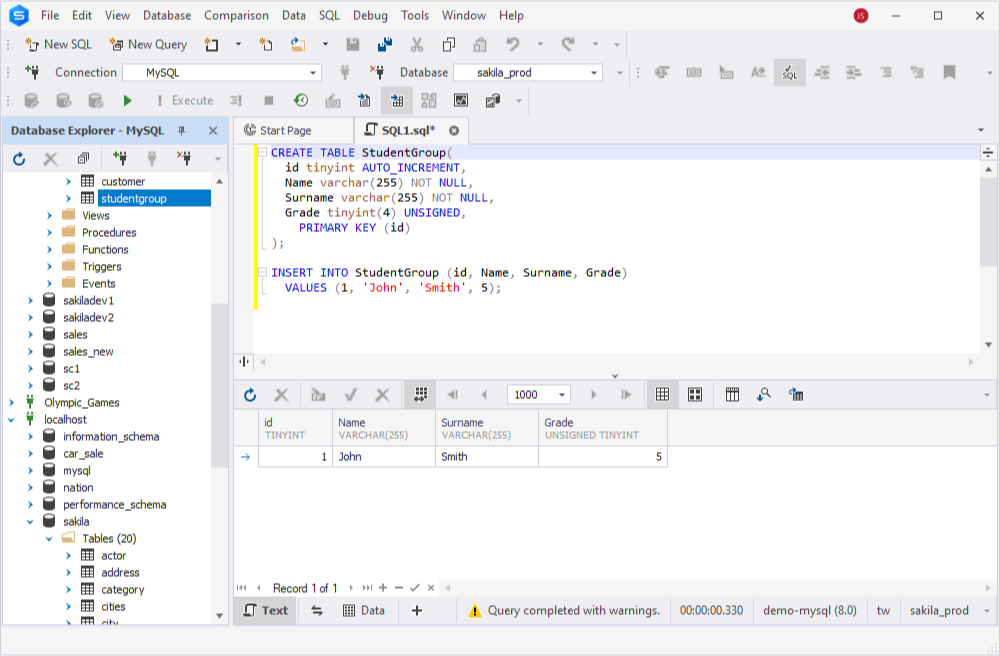
But if we insert the value not included in the range and try to retrieve data,
INSERT INTO StudentGroup (id, Name, Surname, Grade)
VALUES (1, 'John', 'Smith', -5); we’ll get the error ‘Out of range value for column ‘Grade’ at row 1′:

Note that starting with MySQL 8.0, a display width was deprecated for TINYINT and you should consider it when migrating to a new version. However, this deprecation did not affect TINYINT(1), but matters for TINYINT(4).
SMALLINT Example
SMALLINT is a small integer. The SMALLINT range for SIGNED values is from -32768 to 32767. The minimum and maximum values for SMALLINT UNSIGNED are 0 and 65535 respectively. The size is 2 bytes per row.
An example of how to use SMALLINT is as follows. Create a SmallintTable table using the CREATE statement:
CREATE TABLE SmallintTable(
ID smallint AUTO_INCREMENT,
value_1 smallint SIGNED,
value_2 smallint(6) UNSIGNED,
PRIMARY KEY (id)
);Insert column values that correspond to the SMALLINT range and execute the query:
INSERT INTO SmallintTable (ID, value_1, value_2)
VALUES (1, -768, 0);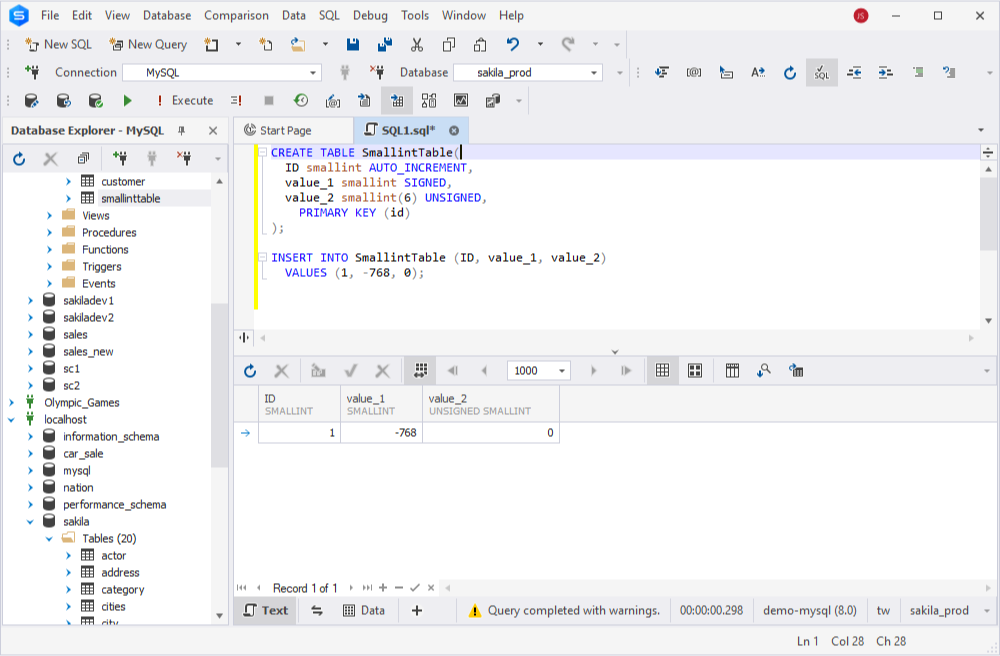
Now, change the values by inserting data that is not included in the SMALLINT range.
INSERT INTO SmallintTable (ID, value_1, value_2)
VALUES (1, 0, 65536);As a result, you will see an error message that the values are out of the range.
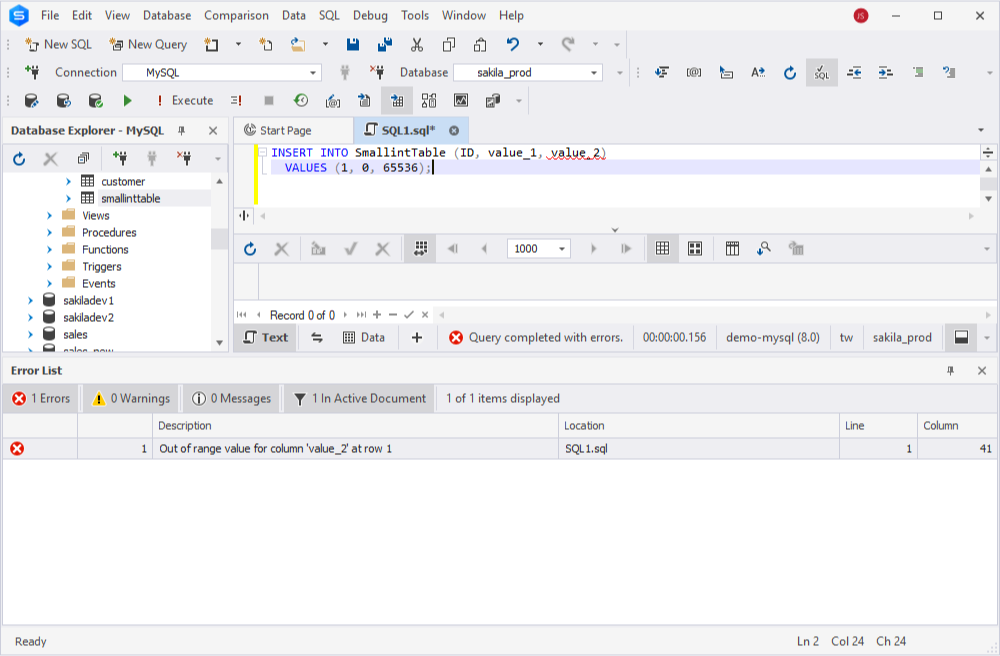
Note that starting with MySQL 8.0, a display width was deprecated for SMALLINT and you should take it into account when migrating to a new version. However, this deprecation did not affect SMALLINT(1).
MEDIUMINT Example
MEDIUMINT is a medium-sized integer. The minimum and maximum values for MEDIUMINT SIGNED are -8388608 and 8388607 respectively. The range for minimum and maximum UNSIGNED values equals 0 and 16777215 respectively. The size is 3 bytes per row.
An example of how to use MEDIUMINT is as follows. First, create a MediumIntTable table with the CREATE statement.
CREATE TABLE MediumIntTable(
ID mediumint AUTO_INCREMENT,
value_1 mediumint,
value_2 mediumint(6) UNSIGNED,
PRIMARY KEY (ID)
);Then, add correct values to the query.
INSERT INTO MediumIntTable (ID, value_1, value_2)
VALUES (5, -1234567, 1234567);
After that, modify the values to the ones that exceed the allowable range (insert a number in the value_2 column that is not included in the MEDIUMINT range):
INSERT INTO MediumIntTable (ID, value_1, value_2)
VALUES (5, 8388607, -16777215);As a result, the error message informing that the value_2 is out of the range appears.
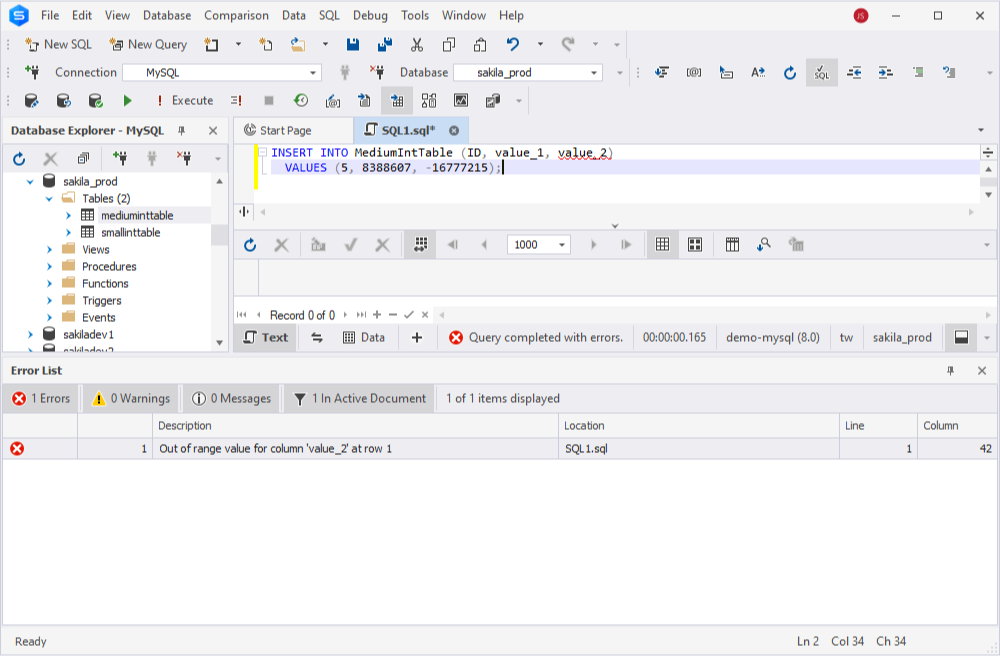
Note that starting with MySQL 8.0, a display width was deprecated for MEDIUMINT and you should consider it when migrating to a new version. However, this deprecation did not affect MEDIUMINT(1).
BIGINT Example
BIGINT is a large integer. The minimum and maximum values for SIGNED are – -263 and 263-1 respectively. The range for minimum and maximum values for UNSIGNED equals 0 and 264-1 respectively. The size is 8 bytes per row.
An example of how to use BIGINT is as follows. Let’s create a BigIntTable table with BIGINT data type and the AUTO_INCREMENT attribute for the ID column. Then, add to the query a negative number as a value_1 and a positive number as a value_2 that are included in the range.
--create a table
CREATE TABLE BigIntTable(
ID bigint AUTO_INCREMENT,
value_1 bigint,
value_2 bigint(20) UNSIGNED,
PRIMARY KEY (ID)
);
-- insert data
INSERT INTO BigIntTable (ID, value_1, value_2)
VALUES (2, -72036854775808, 9223372036854775808);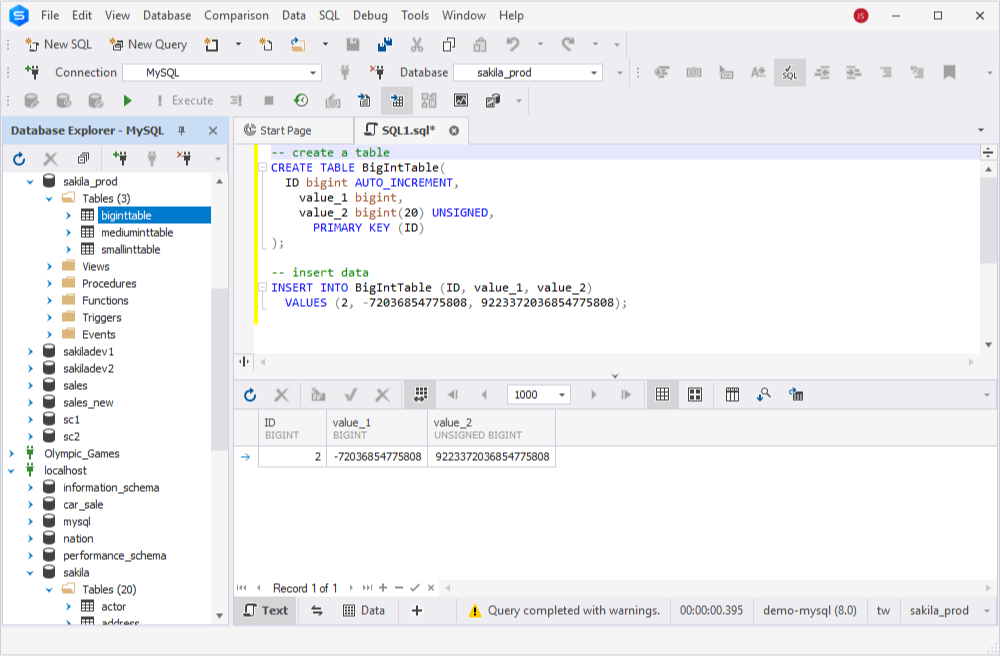
Once done, modify the values to the ones that exceed the allowable range.
INSERT INTO BigIntTable (ID, value_1, value_2)
VALUES (2, -72036854775808, 99223372036854775808); As a result, the error message informing that the value_2 is out of the range appears.
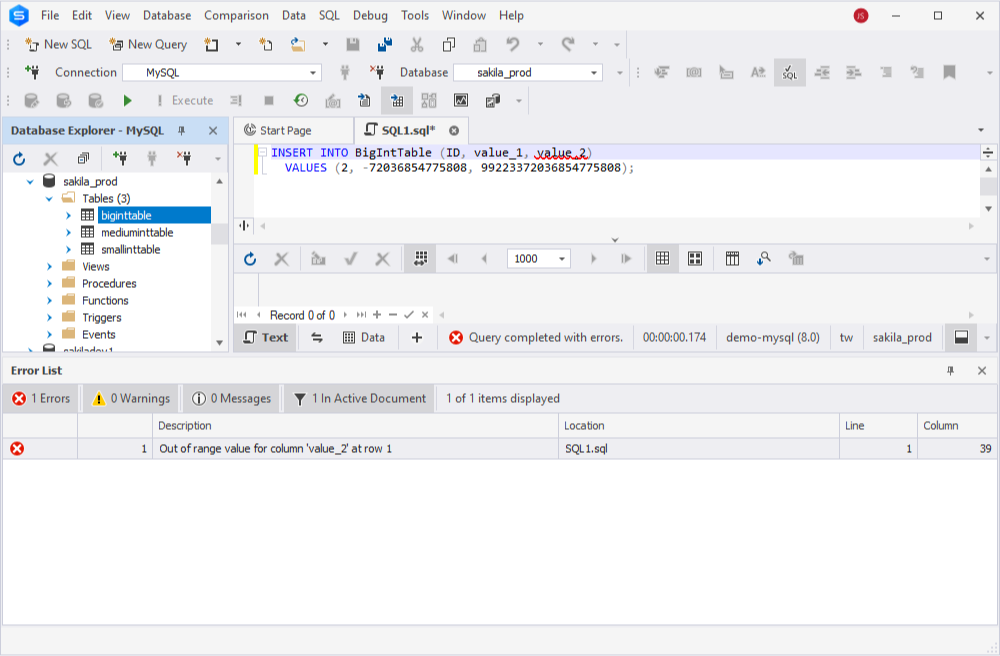
We would like to mention that using INT as a primary key, foreign key, or index instead of BIGINT can significantly improve performance, save disk space, and decrease index size.
Note that starting with MySQL 8.0, a display width was deprecated for BIGINT and you should consider it when migrating to a new version. However, this deprecation did not affect BIGINT(1).
Interested in mastering MySQL queries? We’ve got you covered! Check these materials to learn about MySQL Explain option, MySQL Query Builder and code editor tool to ensure immaculate syntax.
Conclusion
In the article, we have reviewed MySQL INTEGER data types, SIGNED and UNSIGNED values, AUTO_INCREMENT, ZEROFILL, and display_width attributes. Depending on your projects, you should choose which INTEGER data type suits you most. Also, the article provides examples of how and when to INTEGER data types in MySQL.
Download a 30-day free trial version to try and assess all valuable and advanced features of dbForge Studio for MySQL and other dbForge MySQL tools that drastically improve your performance, maximize productivity, and allow you to cope with database development and management tasks quickly and easily.

